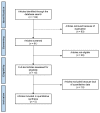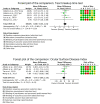Honey-Related Treatment Strategies in Dry Eye Disease
- PMID: 37242545
- PMCID: PMC10222400
- DOI: 10.3390/ph16050762
Honey-Related Treatment Strategies in Dry Eye Disease
Abstract
This systematic review and meta-analysis investigated whether honey-related treatment strategies improve the signs and symptoms of patients with dry eye disease (DED). In March 2023, the following databases were accessed for clinical trials investigating the efficacy of honey-related treatment strategies in DED: PubMed, Web of Science, Google Scholar, and EMBASE. The following data were extracted at baseline and at the last follow-up: Ocular Surface Disease Index, tear breakup time, Schirmer I test, and corneal staining. Data from 323 patients were retrieved (53.3% female, mean age 40.6 ± 18.1 years). The mean follow-up was 7.0 ± 4.2 weeks. All the endpoints of interest significantly improved from baseline to the last follow-up: tear breakup time (p = 0.01), Ocular Surface Disease Index (p < 0.0001), Schirmer I test (p = 0.0001), and corneal staining (p < 0.0001). No difference was found in tear breakup time (p = 0.3), Ocular Surface Disease Index (p = 0.4), Schirmer I test (p = 0.3), and corneal staining (p = 0.3) between the honey-related treatment strategies and the control groups. According to our main results, honey-related treatment strategies are effective and feasible to improve symptoms and signs of DED.
Keywords: Manuka; Royal Jelly; dry eye disease; honey; keratoconjunctivitis sicca; xerophthalmus.
Conflict of interest statement
The authors declare no conflict of interest.
Figures
References
-
- Nagino K., Sung J., Oyama G., Hayano M., Hattori N., Okumura Y., Fujio K., Akasaki Y., Huang T., Midorikawa-Inomata A., et al. Prevalence and characteristics of dry eye disease in Parkinson’s disease: A systematic review and meta-analysis. Sci. Rep. 2022;12:18348. doi: 10.1038/s41598-022-22037-y. - DOI - PMC - PubMed
-
- Hazra D., Yotsukura E., Torii H., Mori K., Maruyama T., Ogawa M., Hanyuda A., Tsubota K., Kurihara T., Negishi K. Relation between dry eye and myopia based on tear film breakup time, higher order aberration, choroidal thickness, and axial length. Sci. Rep. 2022;12:10891. doi: 10.1038/s41598-022-15023-x. - DOI - PMC - PubMed
Publication types
LinkOut - more resources
Full Text Sources





